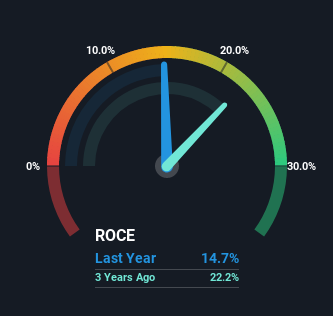Sarveshwar Foods' (NSE:SARVESHWAR) Returns On Capital Not Reflecting Well On The Business

Finding a business that has the potential to grow substantially is not easy, but it is possible if we look at a few key financial metrics. In a perfect world, we'd like to see a company investing more capital into its business and ideally the returns earned from that capital are also increasing. Basically this means that a company has profitable initiatives that it can continue to reinvest in, which is a trait of a compounding machine. In light of that, when we looked at Sarveshwar Foods (NSE:SARVESHWAR) and its ROCE trend, we weren't exactly thrilled.
Understanding Return On Capital Employed (ROCE)
For those that aren't sure what ROCE is, it measures the amount of pre-tax profits a company can generate from the capital employed in its business. The formula for this calculation on Sarveshwar Foods is:
Return on Capital Employed = Earnings Before Interest and Tax (EBIT) ÷ (Total Assets - Current Liabilities)
0.15 = ₹321m ÷ (₹4.9b - ₹2.8b) (Based on the trailing twelve months to September 2022).
Therefore, Sarveshwar Foods has an ROCE of 15%. That's a relatively normal return on capital, and it's around the 13% generated by the Food industry.
Check out the opportunities and risks within the IN Food industry.

While the past is not representative of the future, it can be helpful to know how a company has performed historically, which is why we have this chart above. If you're interested in investigating Sarveshwar Foods' past further, check out this free graph of past earnings, revenue and cash flow.
What Can We Tell From Sarveshwar Foods' ROCE Trend?
In terms of Sarveshwar Foods' historical ROCE movements, the trend isn't fantastic. To be more specific, ROCE has fallen from 35% over the last five years. However, given capital employed and revenue have both increased it appears that the business is currently pursuing growth, at the consequence of short term returns. If these investments prove successful, this can bode very well for long term stock performance.
On a side note, Sarveshwar Foods has done well to pay down its current liabilities to 56% of total assets. So we could link some of this to the decrease in ROCE. Effectively this means their suppliers or short-term creditors are funding less of the business, which reduces some elements of risk. Some would claim this reduces the business' efficiency at generating ROCE since it is now funding more of the operations with its own money. Keep in mind 56% is still pretty high, so those risks are still somewhat prevalent.
Our Take On Sarveshwar Foods' ROCE
In summary, despite lower returns in the short term, we're encouraged to see that Sarveshwar Foods is reinvesting for growth and has higher sales as a result. And the stock has done incredibly well with a 332% return over the last three years, so long term investors are no doubt ecstatic with that result. So while the underlying trends could already be accounted for by investors, we still think this stock is worth looking into further.
One more thing: We've identified 4 warning signs with Sarveshwar Foods (at least 3 which are significant) , and understanding them would certainly be useful.
While Sarveshwar Foods isn't earning the highest return, check out this free list of companies that are earning high returns on equity with solid balance sheets.
New: Manage All Your Stock Portfolios in One Place
We've created the ultimate portfolio companion for stock investors, and it's free.
• Connect an unlimited number of Portfolios and see your total in one currency
• Be alerted to new Warning Signs or Risks via email or mobile
• Track the Fair Value of your stocks
Have feedback on this article? Concerned about the content? Get in touch with us directly. Alternatively, email editorial-team (at) simplywallst.com.
This article by Simply Wall St is general in nature. We provide commentary based on historical data and analyst forecasts only using an unbiased methodology and our articles are not intended to be financial advice. It does not constitute a recommendation to buy or sell any stock, and does not take account of your objectives, or your financial situation. We aim to bring you long-term focused analysis driven by fundamental data. Note that our analysis may not factor in the latest price-sensitive company announcements or qualitative material. Simply Wall St has no position in any stocks mentioned.
About NSEI:SARVESHWAR
Sarveshwar Foods
Manufactures and sells of basmati and non basmati rice in India.
Solid track record with mediocre balance sheet.
Similar Companies
Market Insights
Community Narratives



